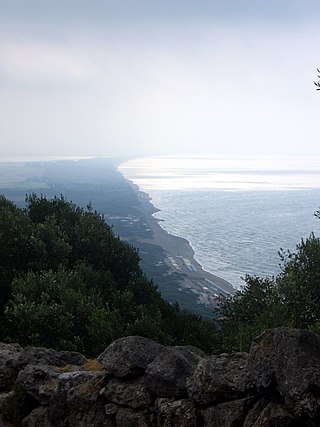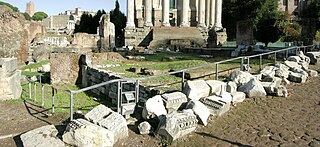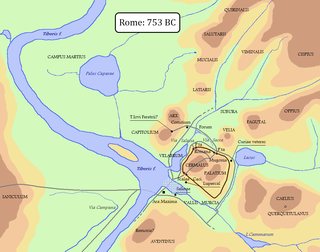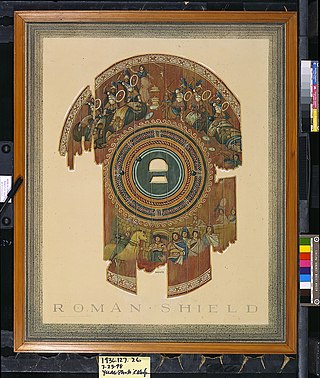Related Research Articles

The Roman Forum, also known by its Latin name Forum Romanum, is a rectangular forum (plaza) surrounded by the ruins of several important ancient government buildings at the centre of the city of Rome. Citizens of the ancient city referred to this space, originally a marketplace, as the Forum Magnum, or simply the Forum.

Cosa was an ancient Roman city near the present Ansedonia in southwestern Tuscany, Italy. It is sited on a hill 113 m above sea level and 140 km northwest of Rome on the Tyrrhenian Sea coast. It has assumed a position of prominence in Roman archaeology owing to its excavation.

The Regia was a two-part structure in Ancient Rome lying along the Via Sacra at the edge of the Roman Forum that originally served as the residence or one of the main headquarters of kings of Rome and later as the office of the pontifex maximus, the highest religious official of Rome. It occupied a triangular patch of terrain between the Temple of Vesta, the Temple of Divus Julius and Temple of Antoninus and Faustina. Only the foundations of Republican/Imperial Regia remain. Like the Curia it was destroyed and rebuilt several times, as far back as the Roman monarchy. Studies have found multiple layers of similar buildings with more regular features, prompting the theory that this "Republican Regia" was to have a different use.

Mikhail Ivanovich Rostovtzeff, or Rostovtsev, was a Russian historian whose career straddled the 19th and 20th centuries and who produced important works on ancient Roman and Greek history. He was a member of the Russian Academy of Science, the American Academy of Arts and Sciences, and the American Philosophical Society.
Emeline Hurd Hill Richardson was an American classical archaeologist and Etruscan scholar. Hill was the daughter of William Hurd Hill and Emeleen Carlisle (Hill). She studied at Radcliffe College, receiving an A.B. in 1932 and an M.A. in 1935. In 1935/36 she studied with Bernard Ashmole at the University of London. She completed her Ph.D. in 1939 at Radcliffe College. From 1941 to 1949 she was on the faculty of Wheaton College in Norton, Massachusetts. In 1950, Emeline Hill Richardson held a stipend at the American Academy in Rome and was involved in the Cosa excavations. She married Lawrence Richardson in 1952. She lectured both at Stanford and Yale Universities.
Herbert Bloch was a professor of Classics at Harvard and a renowned authority on Greek historiography, Roman epigraphy and archaeology, medieval monasticism, and the transmission of classical culture and literature.
Otto Johannes Brendel was a German art historian and scholar of Etruscan art and archaeology.

The Temple of Antoninus and Faustina is an ancient Roman temple in Rome, which was later converted into a Roman Catholic church, the Chiesa di San Lorenzo in Miranda or simply "San Lorenzo in Miranda". It is located in the Forum Romanum, on the Via Sacra, opposite the Regia.

The Comitium was the original open-air public meeting space of Ancient Rome, and had major religious and prophetic significance. The name comes from the Latin word for "assembly". The Comitium location at the northwest corner of the Roman Forum was later lost in the city's growth and development, but was rediscovered and excavated by archaeologists at the turn of the twentieth century. Some of Rome's earliest monuments; including the speaking platform known as the Rostra, the Columna Maenia, the Graecostasis and the Tabula Valeria were part of or associated with the Comitium.

Arx is a Latin word meaning "citadel". In the ancient city of Rome, the arx was located on the northern spur of the Capitoline Hill, and is sometimes specified as the Arx Capitolina.

Giacomo Boni was an Italian archaeologist specializing in Roman architecture. He is most famous for his work in the Roman Forum.
John Peter Oleson is a Canadian classical archaeologist and historian of ancient technology. His main interests are the Roman Near East, maritime archaeology, and ancient technology, especially hydraulic technology, water-lifting devices, and Roman concrete construction.

Clark Hopkins was an American archaeologist. During the 1930s he led the joint French-American excavations at Dura Europos. In later years he was professor of art and archeology at the University of Michigan.
Lawrence Richardson Jr. was an American classicist and ancient historian educated at Yale University who was a member of the faculty of classics at Duke University from 1966 to 1991. He was married to the classical archaeologist Emeline Hill Richardson. Richardson received numerous fellowships, including a Fulbright and a Guggenheim, and support from the American Council of Learned Societies. He was a Fellow of the American Academy in Rome (1950) and field director of the Academy's Cosa excavations (1952–1955). He was a resident of the American Academy in Rome (1979) and was its Mellon professor-in-charge of the School of Classical Studies (1981). In 2012 he was awarded the Gold Medal of the Archaeological Institute of America.
The Archives at the American Academy in Rome (AAR) are digitized archaeological and photographic collections assisting in the preservation and conservation of the cultural heritage of Rome.
Cleo Rickman Fitch was an American archaeological researcher who specialized in Roman lamps.

Anna Marguerite McCann was an American art historian and archaeologist. She is known for being an early influencer—and the first American woman—in the field of underwater archaeology, beginning in the 1960s. McCann authored works pertaining to Roman art and Classical archaeology, and taught both art history and archaeology at various universities in the United States. McCann was an active member of the Archaeological Institute of America, and received its Gold Medal Award in 1998. She also published under the name Anna McCann Taggart.
Norma Wynick Goldman was an American classics scholar, author, professor at Wayne State University, and president of the Detroit Classical Association. Her works include textbooks of the Latin language as well as studies of Roman lamps, the architecture of the Janiculum Hill in Rome, and Roman costumes.

The Mithraeum of Dura Europos was found during excavations in the city in 1934. It is considered to be one of the best-preserved and best-documented cult buildings of Mithraism.

The Homeric shield is one of three figural painted shields found together in an embankment within a Roman garrison during the excavations of Dura-Europos. Dura-Europos was a border city of various empires throughout antiquity, and in modern archaeology is noteworthy for its large amount of well-preserved artifacts. Having been virtually untouched for centuries, and with favorable soil, an unusual amount of organic material has been preserved at Dura-Europos. This shield and those found alongside it date from the middle of the 3rd century CE, a period in which a large portion of the city was co-opted as a Roman military base. The shields were deliberately discarded unfinished during the Sassanian siege of Dura Europos. It is widely believed to depict two scenes from the Trojan war: the admission of the Trojan horse into Troy, and the subsequent sack of the city. It is one of few examples of Roman painting on wood, and one of very few Roman painted wooden shields to have survived from antiquity. The shield has now deteriorated beyond most detail being discernible to the naked eye. This is due to the unintended adverse effects of a binding agent applied to the shield in the 1930s in the hopes of preserving the pigmentation.
References
- ↑ Scott, Russell T. (1988). "Frank Edward Brown, 1908-1988". American Journal of Archaeology. 92 (4): 577–579. ISSN 0002-9114.
- ↑ "Frank E. Brown Dies; Archeologist Was 79". The New York Times. 1988-03-03. ISSN 0362-4331 . Retrieved 2023-02-17.
- ↑ T. Macci Plauti Pseudolus. Yale university press; H. Milford, Oxford University Press. 1932. hdl:10079/bibid/5424493.
- ↑ M. Rahim Shayegan (15 September 2011). Arsacids and Sasanians: Political Ideology in Post-Hellenistic and Late Antique Persia. Cambridge University Press. pp. 214–. ISBN 978-0-521-76641-8.
- ↑ Frank E. Brown (1949). Cosa: Exploration in Etruria.
- ↑ Stephen L. Dyson (1 October 2008). In Pursuit of Ancient Pasts: A History of Classical Archaeology in the Nineteenth and Twentieth Centuries. Yale University Press. pp. 228–. ISBN 978-0-300-13497-1.
- ↑ Frank Edward Brown (1980). Cosa: The Making of a Roman Town. University of Michigan Press. ISBN 978-0-472-04100-8.
- ↑ Frank Edward Brown; Emeline Hill Richardson; L. Richardson (1960). Cosa II: The Temples of the Arx. American Academy in Rome.
- ↑ Frank Edward Brown; Emeline Hill Richardson; Lawrence Richardson (1993). Cosa III: the buildings of the forum: colony, municipium, and village. Published for the American Academy in Rome by Pennsylvania State University Press. ISBN 978-0-271-00825-7.
- ↑ Frank E. Brown,"The Regia." Memoirs of the American Academy in Rome 12
- ↑ http://www.studiromani.it/html/elencoCultori.htm Archived 2019-08-14 at the Wayback Machine I "Cultori di Roma" dal 1955 ad oggi
- ↑ "Civic honours | Eastleigh Borough Council".
- Adapted from: R. T. Scott. "Frank Edward Brown, 1908-1988." American Journal of Archaeology 92 (1988).